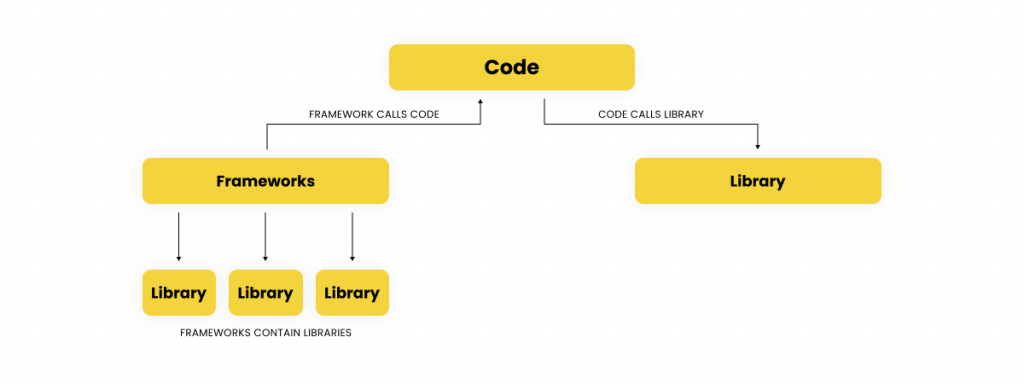There are a few significant differences between a library and a framework. Libraries and frameworks are both reusable codes with the same purpose – to save programmers’ time. Learn more about similarities and fundamental distinctions.
What is a library?
A library is a collection of reusable functions and classes that can be used by a developer when needed. The code for functions is in a library; therefore, developers do not need to write code for specific functionality. They may call and use code from the library.
Why do we need a library?
A library can be very useful, especially when a developer wants to use already written code from the library while working on some functionalities. It saves programmers time and speeds up application development.
Advantages of a library
- improves a program’s performance by allowing the compiler to include a library selectively at run time,
- provides reusable functions that may be referenced without having to define them explicitly in the code,
- it eliminates the need to write code for advanced features,
- it saves us from having to develop code to address the same problem several times,
- rather than dealing with global state management, such as HTTP and routing, a library focuses solely on the functionality it provides,
- allows us to select libraries that we wish to use,
- reduces the cost of application development,
- motivates programmers to concentrate on creating customizable and reusable libraries,
- pre-tested code for a variety of environments and use cases.
Limitations of a library
- while we use a library, we are binding our code to that library,
- if we want to use a new library, our existing code may need to be modified,
- due to dependency conflicts, using many libraries may have a negative impact on an application’s performance,
- incompatibility difficulties with the new version of the library may arise,
- libraries are sometimes targets of cyberattacks.
What is a framework?
A framework is a piece of code that forces the project structure. A framework dictates applications’ standards, e.g., defines design parameters. Functions are reusable and can be used in different places in the project.
What a framework does?
A framework can make the app creation process easy and optimized. The user does not have to create every function from scratch because a framework provides built-in functionalities for faster development.
Advantages of a framework
- a modification in one area of the application has no impact on the rest of it,
- provides network traffic caching and optimization,
- allows for more efficient web creation with less code,
- creates rich and dynamic content for a better user experience,
- supports the development of cross-platform applications,
- some JavaScript frameworks, such as Angular, are MVC-based, which explains why data binding is used.
Limitations of a framework
- a framework’s ready-to-use features discourage programmers from developing a thorough grasp of the programming language,
- using a framework might make application development more difficult at times,
- the amount of functionality that can be modified is restricted,
- we must select the appropriate framework for the application’s scalability, or else performance and user experience may suffer; otherwise, it may have a negative impact on user experience and performance,
- it might be difficult to distinguish business logic from display logic in MVC,
- every version requires us to be up-to-date on new/deprecated features.

You might also be interested in this article:
7 Famous Applications Built with Node.js

Key differences between a library and a framework
Library vs. Framework: Definition
A library is a collection of functions and classes used by developers to perform tasks.
A framework is a piece of code that dictates the architecture or the project’s structure.
Library vs. Framework: Inversion of control
A library is called by the user, who is in complete control of inserting or using the library.
A framework calls the user and tells where to implement the specific part of the code.
Library vs. Framework: Main function
A library is essential in the binding and linking process.
A framework provides a standard way to create and develop applications.
Library vs. Framework: Purpose in software development
A library provides reusable software functionality.
A framework makes the software development process less complex.
Library vs. Framework: Flexibility
A library is a more flexible and controllable solution for developers.
A framework has an enforced structure.
Is React a framework or a library?
The official React website confirms that React is a JavaScript library created for building UI interfaces and components. However, many developers over the years seem to have a different opinion about React’s status, calling it a framework. Here are some debatable facts:
React as a library
- React has the main purpose: it allows to build responsive and fast UI interfaces,
- the definition of a library is that it can be simply incorporated into an existing technology stack, which is precisely what React does,
- React may simply be replaced with another JavaScript library that provides equivalent functionality.
React as a framework
- to create React-based applications, a developer needs packages and tools. Currently, there are available all React-specific tools and frameworks required to build an app (for example, Next.js, Gatsby, Redwood.js),
- related libraries have to work in an opinionated way.
Considering the facts mentioned above, React is a library that functions similarly to the js framework. For more information, go to our comparison Angular vs. React.
Library vs. Framework – conclusion
When facing a dilemma about choosing a framework or a library in application development, you should think about control. As we have established, the main difference between them is the inversion of control. Libraries seem to be more flexible and controllable choices, while frameworks are more structured and standardized.
